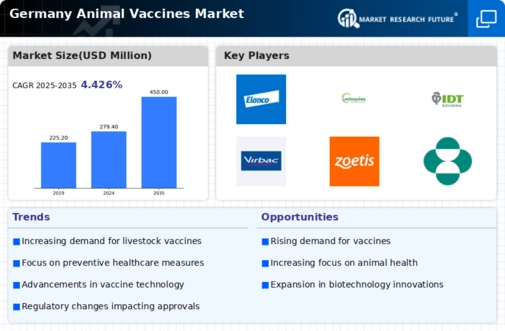Emerging Zoonotic Diseases
The emergence of zoonotic diseases poses a significant threat to both animal and human health, thereby driving the animal vaccines market. In Germany, the increasing incidence of diseases such as African swine fever and avian influenza has heightened the focus on vaccination as a preventive measure. The government and veterinary authorities are actively promoting vaccination programs to mitigate the risks associated with these diseases. The economic impact of zoonotic diseases can be substantial, with potential losses in the livestock sector reaching millions of euros. Consequently, the urgency to vaccinate animals against these diseases is likely to bolster the demand for vaccines. This trend indicates a growing recognition of the interconnectedness of animal and human health, which is expected to further stimulate the animal vaccines market in Germany.
Rising Animal Health Awareness
The increasing awareness regarding animal health among pet owners and livestock farmers is a crucial driver for the animal vaccines market. In Germany, there is a growing trend towards preventive healthcare, which emphasizes the importance of vaccinations in maintaining animal health. This shift in mindset is reflected in the rising expenditure on veterinary services, which reached approximately €3.5 billion in 2024. As pet ownership continues to rise, with over 50% of households owning pets, the demand for vaccines is likely to increase. Furthermore, livestock farmers are becoming more educated about the benefits of vaccination in preventing disease outbreaks, which can lead to significant economic losses. This heightened awareness is expected to propel the growth of the animal vaccines market in Germany, as stakeholders prioritize the health and well-being of their animals.
Increasing Livestock Production
The increasing demand for livestock products is a significant driver for the animal vaccines market. In Germany, The livestock sector was experiencing growth due to rising consumer demand for meat, dairy, and other animal products. This trend necessitates enhanced animal health management practices, including vaccination, to ensure the productivity and welfare of livestock. The German livestock population is substantial, with millions of cattle, pigs, and poultry requiring regular vaccination to prevent disease outbreaks. As farmers strive to maximize production efficiency, the adoption of vaccination programs is likely to increase. This focus on livestock health not only supports the sustainability of the agricultural sector but also drives the demand for vaccines, thereby contributing to the expansion of the animal vaccines market.
Government Initiatives and Support
Government initiatives aimed at promoting animal health and welfare play a pivotal role in driving the animal vaccines market. In Germany, the government has implemented various programs to support vaccination campaigns, particularly for livestock. These initiatives often include subsidies for vaccine purchases and educational programs for farmers about the importance of vaccination. For instance, the German Federal Ministry of Food and Agriculture has allocated funds to enhance animal health measures, which indirectly boosts the demand for vaccines. Additionally, the government collaborates with veterinary associations to raise awareness about zoonotic diseases, further emphasizing the need for vaccinations. Such support not only encourages compliance with vaccination protocols but also fosters a favorable environment for the growth of the animal vaccines market.
Technological Innovations in Vaccine Development
Technological innovations in vaccine development are transforming the landscape of the animal vaccines market. In Germany, advancements such as recombinant vaccines and mRNA technology are gaining traction, offering more effective and safer options for animal immunization. These innovations not only enhance the efficacy of vaccines but also reduce the time required for development and approval. The market for animal vaccines was projected to grow at a CAGR of approximately 6% from 2025 to 2030, driven by these technological advancements. Furthermore, the ability to produce vaccines that target specific pathogens is likely to improve vaccination rates among livestock and pets. As veterinarians and animal owners become more aware of these innovations, the demand for advanced vaccines is expected to rise, thereby propelling the growth of the animal vaccines market.





















Leave a Comment